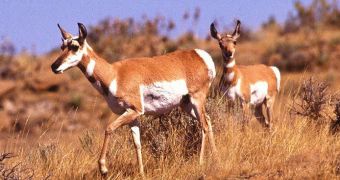Conservation experts are drawing attention to the fact that authorities need to take immediate action on ensuring that the migration routes pronghorns take are not entirely blocked by human development.
This is a real problem the animals deal with, the scientists say. Even though they are the fastest land animals in North America, these antelopes cannot compete with the creeping influence of human activities in their natural habitats.
Such activities include the construction of roads and fences, which significantly narrow down the range of options the antelopes have for migration, OurAmazingPlanet reports.
This species also has the longest migration route of any animal currently living in the continental United States, conservationists and biologists say.
A team of experts and authorities in the US have now started a new study on the pronghorns, which is meant to provide them with more insight into the threats the animals are currently facing.
The investigation will be conducted by a joint team of experts, from the Wildlife Conservation Society (WCS), the Grand Teton National Park and the Wyoming Game and Fish Department.
Groups from these organizations will monitor the migrations of the pronghorn, which travels about 125 to 150 kilometers (80 to 90 miles) each year.
The team will look for obstacles the animals are faced with, such as roads, fences and other human developments, and will also seek to quantify the influence these obstacles have on the antelopes.
“Grand Teton National Park's pronghorn spend half the year outside the boundaries of the national park, and the threats they encounter could influence their long-term viability,” explains Steve Cain.
He holds an appointment as a senior wildlife biologist at the Grand Teton National Park. The expert says that the main point of the investigation will be to analyze the southern portions of the animals' migration route.
This area overlaps lands that contain the richest oil and natural gas reserves in the United States, and the region is now under heavy development.
Past investigations have already demonstrated that obstacles set in the path of the pronghorn can cause significant health and behavioral deficits in the species.
Conservation efforts based on such studies are very important, given that the number of living pronghorns has decreased from 35 million in the 19th century to about 700.000 today.
More than 350,000 of those antelopes live in the state of Wyoming.

 14 DAY TRIAL //
14 DAY TRIAL //